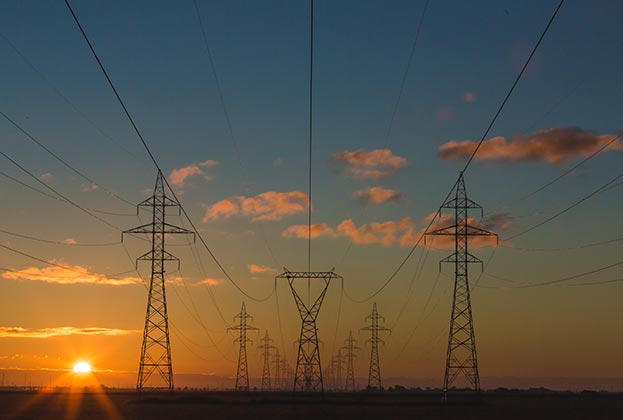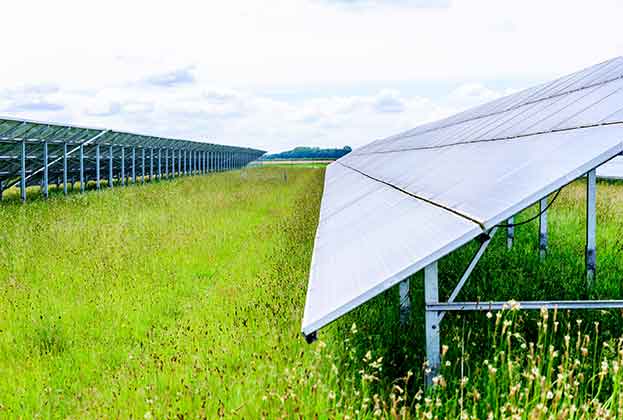Renewable energy will permanently occupy less than 1% of the total UK land area, but it must still compete against existing and emerging land uses
Renewable technologies are energy-dilute, meaning that a large land area is needed to generate each unit of energy. The chart, below, shows how the amount of energy produced per unit area from natural gas is several orders of magnitude greater than biomass, wind and solar. So, will fulfilling the Future Energy Scenarios (FES) 2050 renewable energy targets demand swathes of the UK to be turned over to power generation?
Modelling land use demands
Solar photovoltaics (PV) currently covers just over an estimated 17,000 hectares, less than 0.1% of the total UK land area. To fulfil the most ambitious FES model, “Leading the Way”, Savills research estimates a total of 186,000 hectares will be required, or 0.8% of the total UK land area; less than that covered by sports facilities, including golf courses. This is the most extreme scenario, accounting for increased demands in electricity consumption by consumers but not permitting for any further improvements in solar PV efficiency. Academic studies have shown the amount of energy generated per unit area of solar PV has been increasing over time, meaning 186,000 hectares is likely to be an overestimate.
The land use required by onshore wind to meet the demands of the same scenario initially appear larger. Savills research estimates that wind would require a total land use of 865,000 hectares (3.6% of the UK’s land area). However, only 13,000 hectares of land stand to be directly affected by wind installations, or 0.02% of the UK land area; less than that occupied by landfill or airports. The difference (852,000 hectares) would be only partially compromised. It could not be used for housing or forestry, however agriculture, soil-based carbon and biodiversity projects could continue on land between the turbines.
In all instances, the land requirement is low, but finding appropriate sites remains a challenge. For example, deployment is recommended on land that is not classified as best and most versatile. However the relationship between poorer quality agricultural land and that of the connection points, along with other development factors such as topography, construction access, wind resource and flood risk, all form part of the equation that determines the overall suitability of a site.
.jpg)
Adopting renewables at scale
2015 proved to be a watershed moment for renewables. Savills research shows how the priorities of developers evolved in the face of reformed and reduced subsidy support (see chart, below). Despite a significant decrease in the number of planning applications for solar PV between 2015 and 2016, as well as a slight decrease in onshore wind, there is a gradual increase in the scale of solar PV and battery projects beyond 2015. Battery storage makes a sudden appearance and rapidly rises to prominence in the following years.
The average capacity per application obscures the extensive changes occurring in the world of renewable energy development, most notably for solar PV. The renewable energy planning database indicates that only eight of the 2,750 planning applications for solar PV exceeded the 50 MW limit that tips a project into the realms of a Nationally Significant Infrastructure Project (NSIP). All these projects submitted planning applications during or after 2018, with the majority being after 2020. All exceeded 300 MW. Planning applications for this scale of project are expected to increase in future.
2015 proved to be a watershed moment for renewables. Savills research shows how the priorities of developers evolved in the face of reformed and reduced subsidy support
Andrew Teanby, Associate Director, Rural Research
In 2020 and 2021, applications for solar PV projects between 49 and 50 MW (the largest permissible without becoming an NSIP) accounted for around a fifth of all applications; each of these sites is likely to require approximately 100 hectares of land. Before 2015, sites of this capacity never exceeded 1%. It is clear developers are pursuing scale and recent government consultations on the NSIP planning process indicate a desire to make the process easier and faster.
While energy should demand a relatively small proportion of land nationally, large-scale projects will have a local impact. Taking the rule of thumb that each megawatt of solar PV capacity requires roughly two hectares of land, the very largest will consume as much as 1,000 hectares or more; enough space for two million trees, 14,000 homes, or wheat for 14.5 million loaves of bread per year. The local impact of this scale of solar PV development will necessitate careful community engagement.
Read the articles within this publication below
.jpg)


